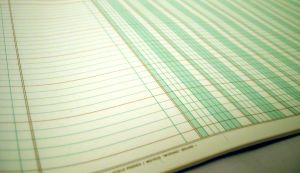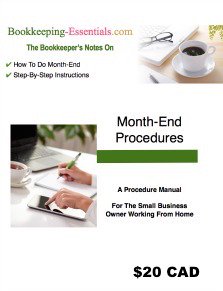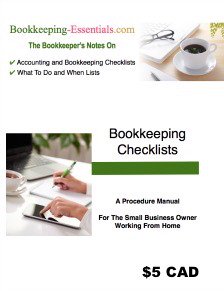
How to Record Basic Bookkeeping Entries
Part 1 - Get It Right The First Time!
by L. Kenway BComm (Retired CPB)
Today, we'll look at how to record some basic bookkeeping entries using examples from my method of recording your accounting journal entries for the do-it-yourself business owner ... just so you get the bookkeeping entry right the first time. :0)
What You'll Find In This Chat

Part 2 of this series covers common but not routine bookkeeping entries. It will deal with capital assets, banking, taxes and year-end.
In this chat, I'll try to keep this really practical. I'm going to cover the routine, basic bookkeeping entries and provide accounting journal entry examples you run across everyday while doing your books.
Soooooo ... do you have your nice hot cup of tea all poured? Are you ready? Are you comfortable? ... Then let's get started.
Advertisements
INDEX for Common Bookkeeping Entries Series
click on image below to go to chat
Link Index
✔ Bookkeeping Entries Link Index |
Part 1
✔ Learning Debits and Credits Tips |
Part 2
✔ 4 Common Bookkeeping Errors |
Basic Bookkeeping Entries - Tips For Learning Debits and Credits
Advertisement
The easiest way to develop a basic understanding of debits and credits is to become familiar with your chart of accounts.
If you are having trouble with debits and credits ... it can be very confusing at first ... you need to take a peek at my "cheat table" .
Keep my "cheat" table open while you work your way through the journal entry... really, really try to figure it out for yourself ... then check your best guess with what you see here on this page.
To help you learn how to work your way through learning your debits and credits, I will start each entry with Mr. Sands's method (see the cheat sheet) of describing:
- what you received or what you bought ... the debit side of the transaction ... the use of funds; and
- where it came from or what you gave ... the credit side of the transaction ... the source of funds.
If you take the time to think like this, you will learn faster than just copying the bookkeeping entries I have here.
You want (yes you do ... you just don't know it yet!) to learn how to think your way through booking an entry.
If you are using computer software like QuickBooks®, this article will help you see exactly what is happening when you book your entries. You can also use Ctrl + Y to open up the journal entry and see your debits and credits posted.
I don't know about you, but if I understand something, I am less likely to make mistakes in the future.
All right, with that said ... here we go ...

Basic Bookkeeping Entries and ...
Accounting Journal Entry Examples
 |
How to Record a Cash Sale |
What you received (debit) - cash to deposit to bank account ... Where it came from (credit) - sale of a product or service
Debit (Increase) Cash in Bank (current asset on balance sheet)
Credit (Increase) Sales Revenue (on income statement)
Credit (Increase) GST/HST Payable and PST Payable if applicable (current liability on balance statement)
 |
How to Record the Sales Discount on a Customer Invoice |
What you received (debit) - cash to deposit to bank account ... Where it came from (credit) - payment on outstanding account receivable with discount taken
To calculate a 2% discount on a $100 customer invoice = $100 x 2 = $2 discount (if paid within 10 days). Therefore the amount owing if paid within 10 days is $98 not $100.
If you recorded the customer invoice at n/30 (e.g. at $100) but the customer pays in time to take the 2/10 discount, then you would make the following entry:
Debit (Increase) Cash to Deposit to Bank Account (current asset on balance sheet) $98
Debit Sales Discounts (Increase) $2 to record the discount taken by the customer
Credit (Decrease) Accounts Receivable (current asset on balance sheet) $100 to clear the receivable
 |
How to Record the Purchase Discount on a Vendor Invoice |
What you received (debit) - reduction of outstanding account payable with discount taken ... What you gave(credit) - cheque written on bank account
To calculate a 2% discount on a $100 invoice = $100 x .02 = $2 discount (if paid within 10 days). Therefore the amount due if paid within 10 days is $98 not $100.
If you recorded the vendor invoice at n/30 (e.g. at $100) but pay in time to take the 2/10 discount, then you would make the following entry:
Debit (Decrease) Accounts Payable (current liability on balance sheet) $100 to clear the payable
Credit (Decrease) Cash in bank (current asset on balance sheet) $98 to write the cheque
Credit (Increase) Purchase Discounts (on income statement) $2 to record the deposit taken
If you recorded the vendor invoice at 2/10 (e.g. at $98) but did not pay in time to take the discount, then you would make the following entry:
Debit (Decrease) Accounts Payable (current liability on balance sheet) $98 to clear the payable
Debit (Decrease) Purchase Discounts (on income statement) $2 to record the deposit taken
Credit (Decrease) Cash in bank (current asset on balance sheet) $100 to write the cheque
 |
How to Record Cash or Cheques For Bank Deposits |
What you received (debit) - cash or cheque ... Where it came from (credit) - sale from the customer.
If you are not extending credit to your customer, your basic bookkeeping entry for bank deposits would be:
Debit (Increase) Cash in Bank
Credit (Increase) Sales (if they paid immediately)
If you are using QuickBooks®, record this transaction through Sales Receipt in the Customer section of the flow chart or the drop down menu. See below for the basic bookkeeping entries.
If you extended credit to your customer and are now receiving a payment to apply to their account, your bookkeeping entry for the bank deposits would be as follows:
Debit (Increase) Cash in Bank
Credit (Increase) Accounts Receivable
If you are using QuickBooks®, you would make this transaction through Receive Payment in the Customer section of the flow chart or the drop down menu. See below for the basic bookkeeping entries.
Basic Bookkeeping Entries For Deposits in QuickBooks®
For both of the transactions above, to record your bank deposit if you are using QuickBooks®, use the Make Deposit function found under Banking ... but only after you have recorded the payment correctly.
It is a two step process and Make Deposit is the second step. Here's how the above entries change when using QuickBooks:
Step One A - If you are not extending credit to your customer, your basic bookkeeping entry when receiving the payment would be entered through Sales Receipt as follows:
Debit (Increase) Undeposited Funds (because you don't take the cash to the bank after every sale ... think of it as "holding drawer" for the cash)
Credit (Increase) Sales (if they paid immediately)
Step One B - If you extended credit to your customer and are now receiving a payment to apply to their account, your bookkeeping entry when you receive the payment would be entered through Receive Payment as follows:
Debit (Increase) Undeposited Funds (because you don't take the cash to the bank after every sale ... think of it as "holding drawer" for the cash)
Credit (Increase) Accounts Receivable
Step Two - When you make the physical bank deposit, your basic bookkeeping entry to capture the bank deposit would be made using the Make Depositfunction:
Debit (Increase) Cash in bank (current asset on balance sheet)
Credit (Decrease) Undeposited Fund (You've removed cash from the "holding drawer" to take to the bank)
 |
How to Record the Payment of an Accounts Payable Invoice |
What you received (debit) - cash to deposit to bank account ... Where it came from (credit) - payment on outstanding account receivable with discount taken
Debit (Decrease) Accounts Payable (current liability on balance sheet)
Credit (Increase) Cash in Bank (current asset on balance sheet)
If you are using QuickBooks®, record this transaction through Pay Bills in the Vendor section of the flow chart or the drop down menu.
To read about a bad habit to avoid when recording this basic bookkeeping entry,click here.
 |
How to Record Bad Debt Allowance and Write-Off a Bad Debt |
What you received (debit) - an estimate of bad debts ...Where it came from (credit) - the reserve allowance.
Do not confuse booking an allowance with an actual bad debt on a specific customer's account. The allowance is just an estimate of the accounts receivable that may not be collectible.
The allowance bookkeeping entry can be done monthly or annually. My recommendation for a home business is to only book (or revise) this entry annually ... and as it is an adjusting entry, it's even better if you leave this entry for your bookkeeper or accountant to do.
If you want your allowance to be in accordance with GAAP, use either the Estimation of Bad Debt Expense method or the Net Realizable Value of Current Receivables method (neither of which will be discussed here).
To book the allowance, at year-end your bookkeeper or accountant will make the following entry:
Debit (Increase) Bad Debt Expense (excluding taxes) (expense account on the income statement)
Credit (Increase) Allowance for Doubtful Accounts (excluding taxes) (a contra account in the current asset section of your balance sheet ... in QuickBooks this account should be an "other current asset" type NOT an "accounts receivable" type)
Notice that the bookkeeping entry did NOT remove the amount from the accounts receivable ledger. The contra account for accounts receivable is the allowance account. It is used to reduce your accounts receivable by the anticipated bad debt amount, allowing the credit history for each individual customer to be retained.
Up until now, you have only booked the expectation that it will be a bad debt. Once you have decided the invoice is uncollectible, you need to do the actual write-off.
You can write-off a bad debt if it has been outstanding for twelve months or there is little probability of recovering the debt such as the customer has gone bankrupt or the customer has moved and you cannot locate their new residence.
To book the reality that the bad debt is uncollectible, make the next bookkeeping entry.
To book an actual bad debt write-off, you remove the accounts receivable from the allowance account NOT the expense account. Here is the basic bookkeeping entry:
Debit (Decrease) Allowance for Doubtful Accounts (net of tax) (a contra account in the current asset section of your balance sheet)
Debit (Decrease) Sales Tax payable (select the correct current liability account on your balance sheet)
Credit (Decrease) the customer's account in Accounts Receivable including tax (current asset)
In QuickBooks write-off the bad debt using a credit memo not a general journal entry. Your "item" will be bad debt which you have defaulted to your allowance account.
Bad debt allowance is NOT used for tax purposes. This means if you are keeping your records on a tax basis not GAAP basis, you do not book an allowance in this manner.
You can find more on this topic including the bookkeeping entries when a bad debt is recovered in the article Home Business Taxes Part 2. While there, make you sure you read about how bad debt affects your GST/HST return.
If you use QuickBooks and want to write off a specific account (as opposed to booking a journal entry), here is the best way to do it.
 |
How to Record a Deposit on a Purchase |
What you bought (debit) - a down payment on an order with a supplier before receiving product/service ...What you gave (credit) - cash, cheque or credit card payment.
If your business put a deposit down on a purchase (before receiving it), then you would just book it the opposite to receiving a customer deposit.
Here's two ways you can choose for this basic bookkeeping entry.
Debit (Increase) Deposits / Retainers (other asset on your balance sheet if it will be outstanding longer than one year)
Credit (Decrease) Cash in Bank OR (Increase) Line of Credit
Debit (Decrease) Accounts Payable (current liability on your balance sheet if it will be outstanding less than one year)
Credit (Decrease) Cash in Bank OR Credit Card
If you choose the second entry, your aged accounts payables report will show a negative balance for the vendor you placed your deposit with.
That's it for today's chat. I'll keep adding basic bookkeeping entries to this list on an ongoing basis ... so you may want to check back regularly as I may not put in on the RSS Feed every time I make an addition ... but instead wait until I have a few bookkeeping entries added.

See you on the next page ...
Your tutor Lake
Home > Small Business Accounting > Basic Bookkeeping Entries
Home > Bookkeeping Entries Index > Routine Bookkeeping Entries
Enjoy A Tea Break With
Me Today. Let's Chat!
Use the search feature to quickly find the
information you're looking for.
Join Me On Facebook
Help support this site by "liking" me! Here's where I post current information.
Listed Under Websites NOT Local Business.
This website is NOT associated with the business operating in Bonnyville AB.





